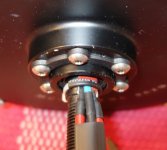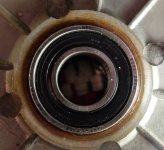teslanv
1 MW
Agreed. 12AWG (4mm2) through the axle. Splice to bigger wire if you like, once outside the axle.Allex said:I believe that 12AWG is sufficient for this motor at least for this particular one. Dont think 10AWG would fit in there.
I managed to get 12AWG PTFE wire through the axle without too much trouble, and the PTFE insulation is far superior to heat shrink tubing.







